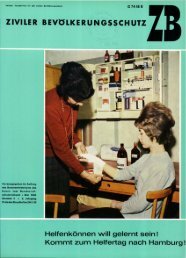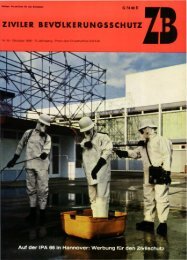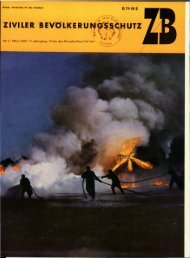Zivilschutz- Forschung - Bundesverwaltungsamt
Zivilschutz- Forschung - Bundesverwaltungsamt
Zivilschutz- Forschung - Bundesverwaltungsamt
Erfolgreiche ePaper selbst erstellen
Machen Sie aus Ihren PDF Publikationen ein blätterbares Flipbook mit unserer einzigartigen Google optimierten e-Paper Software.
73. Hall, S. K. (1995). „Management of chemical disaster victims.“ J Toxicol<br />
Clin Toxicol 33(6): 609-16.<br />
74. Hall, S. K. (1995). „Management of chemical disaster victims.“ J Toxicol<br />
Clin Toxicol 33(6): 609-16.<br />
75. Han, K. H., R. Walker, et al. (1999). „An integrated response to chemical<br />
incidents – the UK perspective.“ Resuscitation 42(2): 133-40.<br />
76. Hansen, D. J. (1999). „DOE emergency planning & emergency management<br />
using emergency response planning guidelines (ERPGS) and temporary<br />
emergency exposure levels (TEELs).“ Drug Chem Toxicol 22(1): 15-23.<br />
77. Harrison, M., T. C. Aw, et al. (1991). „Major chemical disasters.“ Bmj<br />
302(6777): 657.<br />
78. Hasegawa, K. and Y. Li (2000). „Explosion investigation of asphalt-salt mixtures<br />
in a reprocessing plant.“ J Hazard Mater 79(3): 241-67.<br />
79. Hay, A. and G. Roberts (1990). „The use of poison gas against the Iraqi<br />
Kurds: analysis of bomb fragments, soil, and wool samples.“ Jama 263(8):<br />
1065-6.<br />
80. Helfenstein, U., U. Ackermann-Liebrich, et al. (1991). „The environmental<br />
accident at 'Schweizerhalle' and respiratory diseases in children: a time series<br />
analysis.“ Stat Med 10(10): 1481-92.<br />
81. Heller, O., Y. Aldar, et al. (1991). „An argument for equipping civilian hospitals<br />
with a multiple respirator system for a chemical warfare mass casualty<br />
situation.“ Isr J Med Sci 27(11-12): 652-5.<br />
82. Henderson, D. A. (1999). „The looming threat of bioterrorism.“ Science<br />
283(5406): 1279-82.<br />
83. Henretig, F. (2001). „Biological and chemical terrorism defense: a view from<br />
the front lines of public health.“ Am J Public Health 91(5): 718-20.<br />
84. Hoeltge, G. A., A. Miller, et al. (1993). „Accidental fires in clinical laboratories.“<br />
Arch Pathol Lab Med 117(12): 1200-4.<br />
85. Holstege, C. P., M. Kirk, et al. (1997). „Chemical warfare. Nerve agent poisoning.“<br />
Crit Care Clin 13(4): 923-42.<br />
86. Janousek, J. T., D. E. Jackson, et al. (1999). „Mass casualty triage knowledge<br />
of military medical personnel.“ Mil Med 164(5): 332-5.<br />
87. Jayaraman, K. S. (1987). „Bhopal aftermath re-assessed.“ Nature 329(6142):<br />
752.<br />
88. Kales, S. N., G. N. Polyhronopoulos, et al. (1997). „Medical surveillance of<br />
hazardous materials response fire fighters: a two-year prospective study.“ J<br />
Occup Environ Med 39(3): 238-47.<br />
89. Kapias, T., R. F. Griffiths, et al. (2001). „Spill behaviour using REACT-<br />
POOL. Part II. Results for accidental releases of silicon tetrachloride<br />
(SiCl(4)).“ J Hazard Mater 81(3): 209-22.<br />
90. Kasthuri, A. S., A. B. Pradhan, et al. (1990). „Nuclear, biological and chemical<br />
warfare. Part III: Medical aspects of chemical warfare.“ J Assoc Physicians<br />
India 38(6): 413-4.<br />
226

















